The AMD Ryzen Threadripper 3960X and 3970X Review: 24 and 32 Cores on 7nm
by Dr. Ian Cutress, Andrei Frumusanu & Gavin Bonshor on November 25, 2019 9:05 AM ESTPower Consumption
One of our key conclusions from our Ryzen 9 3950X review is that AMD’s TDP number on the box was now somewhat a blurred line, with the processor instead taking the ‘Package Power Tracking’ or PPT value as its true peak power consumption. This meant that for a processor to have 105 W TDP on the box, the default PPT of 142 W meant that we saw power consumption around 142 W rather than 105 W. One concern going into this review is that AMD would take a similar line with the Zen 2-based Threadripper parts as well.
Both of the TR 3960X and TR 3970X processors have a list box TDP of 280 W, which is a new ‘record’ for high power consumption in a consumer CPU. In the enterprise space we see some specialist processors break the 400W mark, but those CPUs exist in environments with a variety of cooling methods and sound isn’t much of a concern. Conversely, these AMD processors will have to live in a box under someone’s desk, so there has to be a point where the TDP is too much. Last AMD generation was 250W, this one is 280W: if we’re not there already, then this should be a practical limit. AMD of course recommends liquid cooling with a good pump and a big radiator, so anyone buying one of these processors should look into spending at least another $120+ on a good liquid cooling system.
For our power consumption metrics, we performed our usual testing: using an affinity mask to limit the cores in use, implement a high-powered workload, and then measure the power readings 30 seconds in. We take the power readings from the processor itself, using the internal registers that are designed to regulate how much the processor does a form of turbo but also regulate temperatures and so forth. This method is broadly accurate, assuming the motherboard supports the external reporting of these values, but depending on the processor family it also gives us insights into how much power is being derived from the cores individually and the package as a whole.
Here’s what we get for the 24-core 3960X:
When a single core is active, it consumes ~13.5 watts. This slowly goes down when more cores get loaded, but at 6 cores loaded we are still consuming ~12 watts per core. Even at 16 cores loaded, we’re still around 10 watts per core. This is pretty impressive. At full core loading, we’re fluctuating between 6 and 11 watts per core, as workloads get moved around to manage core loading.
From the peak power perspective, we hit 280 W with 22 cores loaded. It drops off a bit after that, like we saw with the Ryzen 9 3950X, but not by much at this time. It should be noted that as we reach these higher values, out of those 280 W, around 205 W is being used by the cores, while 75 W or so is for everything else: that means memory controllers, PCIe root complexes, and the infinity fabric. This 75 W value doesn’t vary that much, starting at 68 W even at single core load. This indicates that either IF doesn’t take much power as more cores are used, or it is on all the time.
Moving to the 3970X, and we see a similar picture:
With more cores, the power is spread around a lot more. One core loaded tops out at 13 watts, and at 11 cores loaded we can still manage above 10 watts per core. When fully loaded, we move down to as low as 3 W per core, but it does average out to around 6 watts per core. Checking the frequency at this loading and despite the 3.7 GHz base frequency, we actually have all the cores at 4.0 GHz. 32 cores at 4.0 GHz? Yes please.
The peak power metrics rise to just over 280 W when we hit 23 cores loaded and stay there, with no dip after hitting the peak. It would seem that the 3970X appears better built in that regard.
If we comment on the power between the cores and everything else, we again get a 205-210 W value for the power in the cores. This leaves 75 W or so for the rest of the chip, almost identical to the 3960X, and again this doesn’t waver much from 1 core loaded to all-cores loaded.
What will be interesting to see will be when we get the 3990X in to test as comparison. I expect that 75W value to go up – even if it goes to 100W, that leaves 180W for 64 cores, or around 3 W per core. Based on my estimates, we could be looking at anywhere from 3.0-3.5 GHz per core, which actually fits in nicely with the frequencies of the EPYC 7H12 which is also a 64-core 280W part, but for the high performance compute market.
When comparing peak power consumption to all the other CPUs in our review, as expected our new CPUs are near the top of the charts.
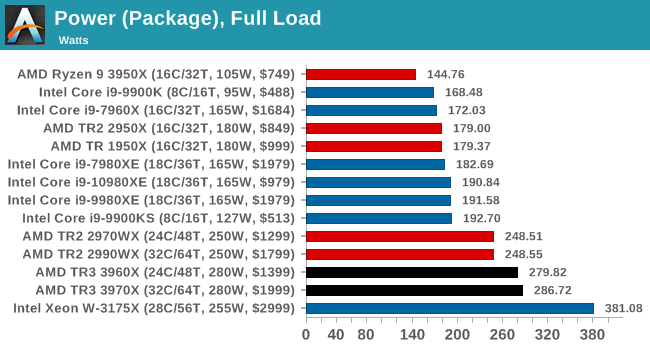
Only the unlocked 28-core from Intel peaks at a higher power, but funnily enough, that should only have a 255W TDP. So for four more cores, AMD’s peak power is still 100W below Intel’s. That’s the ‘power’ of the 7nm process node and some good quality chiplets.


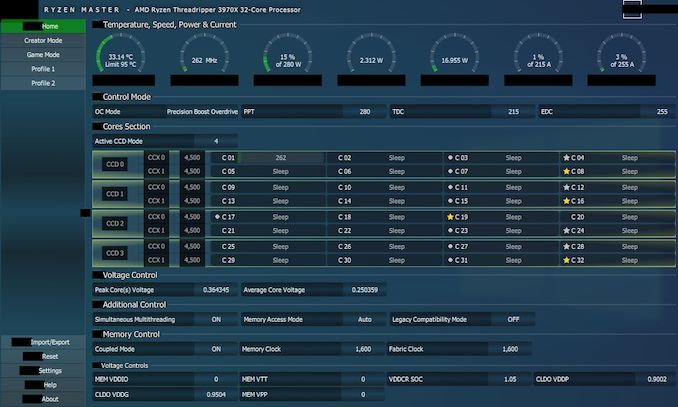
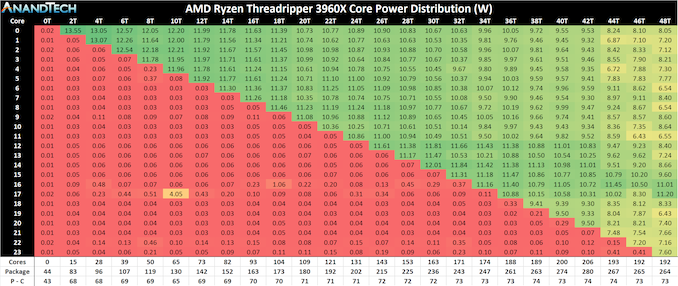
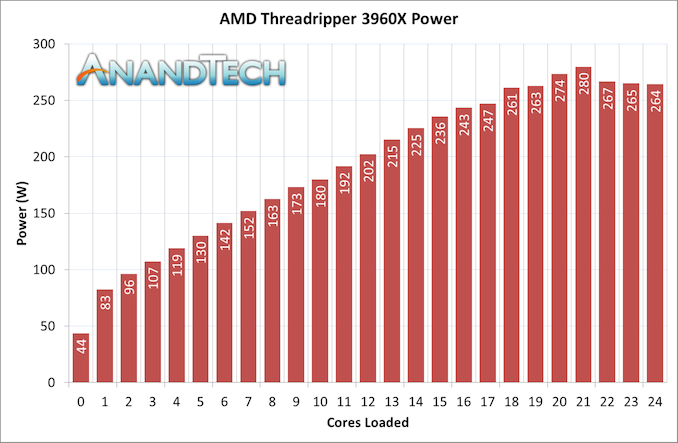
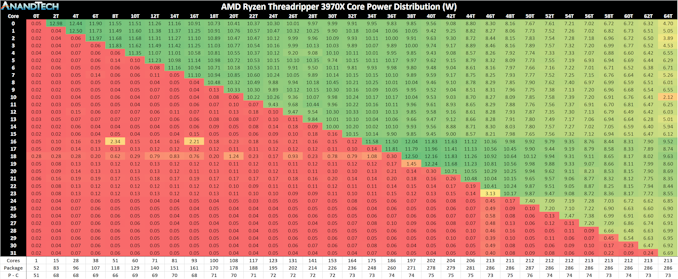
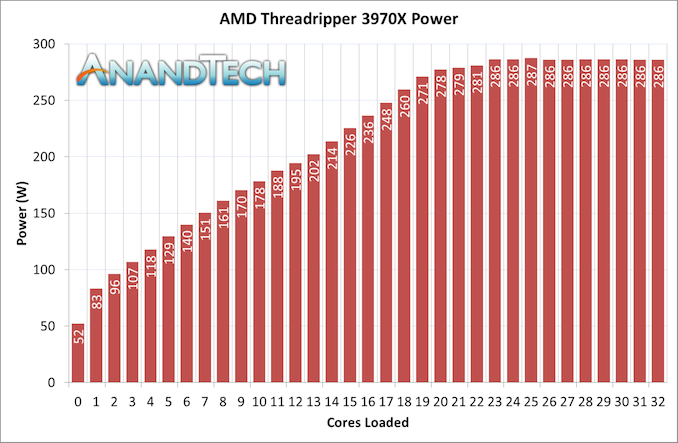








245 Comments
View All Comments
Slash3 - Tuesday, November 26, 2019 - link
AnandTech frustratingly doesn't seem to ever list their memory subtimings, but as they test at "JEDEC" standard, it may be as loose as 2933 CL19-19-19 vs your 2933 CL14. This could easily account for the difference in benchmark results.alufan - Monday, November 25, 2019 - link
So Thread ripper is here, I will never have a use for this chip but I want one...just because, probably the single biggest uplift in CPU performance for a great many years.Still 10 intel featuring articles on the main page vs 4 featuring AMD though, shame really and it would have been nice for you to have a proper dig at intel for its pathetic attempt to skew CPU bench results by moving the embargo forward, try taking a tip off linus man he told it like it was as have many others.
Grobert783 - Monday, November 25, 2019 - link
So many cores and yet no one cares PLUS we all know AMD sucks. Thank youyeeeeman - Monday, November 25, 2019 - link
LolXyler94 - Monday, November 25, 2019 - link
Ah yes, the infamous "Nobody cares" argument of a fanboy.And yet you cares enough to click the article, go to the comment section, and write this comment. I won't comment about your other comment though, clearly you didn't RTFA
darwi - Monday, November 25, 2019 - link
With so much cores Anandtech should consider virtualization benchmark/uses casesthere is some good automated Lab Scripts available.
On Windows Nested Virtualization is still not enabled on AMD Processor.
-> still not announced for Windows 20H1, perhaps for 2OH2 since major overhaul for Azure is underway.
Ryzen Master is still incompatible with VBS (Virtualization based Security).
This situation prevent to test some features in Windows VM :
- With more and more feature relying on virtualization (WSL, Security, workload isolation, ...)
- For advanced scenarios (Labs for testing infrastructure deployment, ESXi, hyper-v, compiler, etc...)
By ignoring the 1k segment AMD could overplay their advantages :
- the cpu is only a part of the package (you have to add a beefy psu and cooling system and a decent amount
of RAM) if you want to make a meaningfull use of such platform.
- the moherboad price take a major rise (Apple accessories manufacturer syndrom ?) - without high ends feature regarding connectivity
where are the multi-gig network and Thunderbolt ports ?, but RGB pins are plenty ...
- forcing the early TR adopters to a 2k-2,5k investment to jump to the TR3+ architecture (if cooler and RAM, PSU remain the same)
and chipset reset could do some damage too.
And finally the 10980XE (with more PCI 3 lanes, and more memory) will not be the best but enough and more affordable.
I'm a an owner of TR 1950X.
Questions :
> Nested Virtualization will eventually comming to AMD ? (for a future interview with AMD CEO/CTO)
> Air Cooling is it still suitable for TR3 ?
And thanx to Anandtech for those reviews and the worth of drilling down into details.
That's my 2cents.
Irata - Monday, November 25, 2019 - link
Wait, what ? The 10980XE has more PCIe lanes than TR3?And the rest...is pot legal where you live?
darwi - Monday, November 25, 2019 - link
I was comparing with the nearest AMD offrer to the 10908XE v: The Ryzen 3950X.Furthermore the PCI4 cards are very few for the moment.
May be there is some room for a TR3 3950X like the TR 1920 in his time.
The 1K is for 1K$.
lobz - Tuesday, November 26, 2019 - link
I usually don't do drugs but I'll have some from what you're having...Xyler94 - Monday, November 25, 2019 - link
In what world is 60 PCIe 4.0 lanes less than 48 PCIe 3.0 lanes?You do know... that PCIe 4 is backwards compatible, so Threadripper has effectively 60 lanes of PCIe 3, right? I don't know about you... but 60 is more than 48...